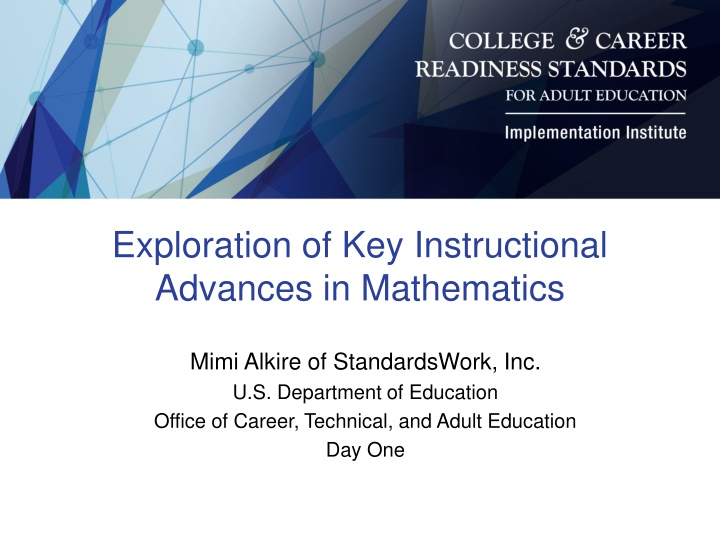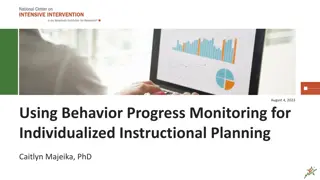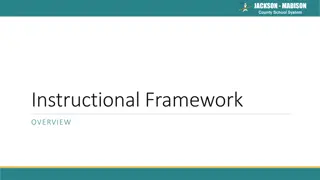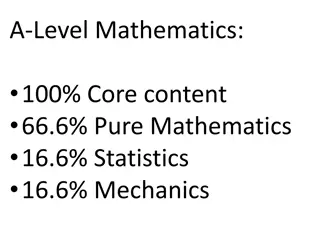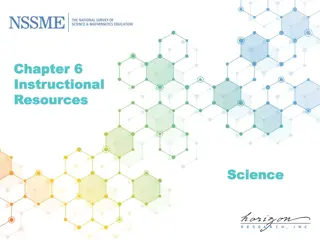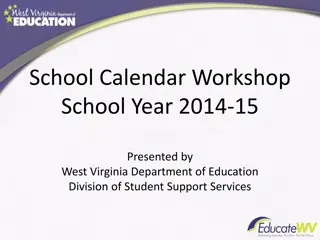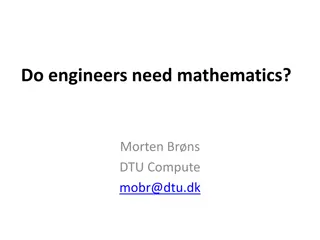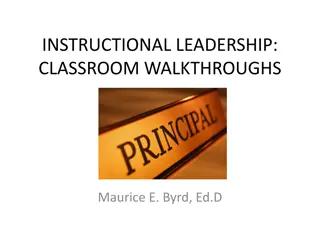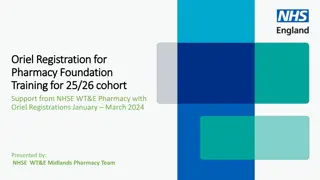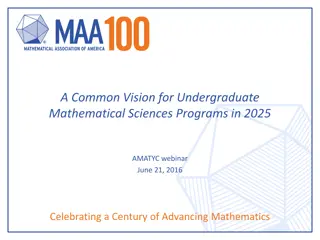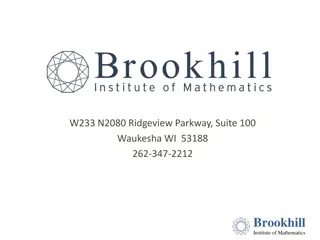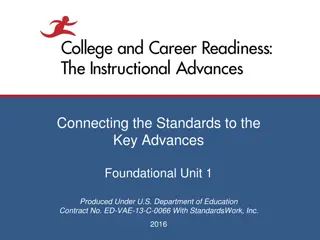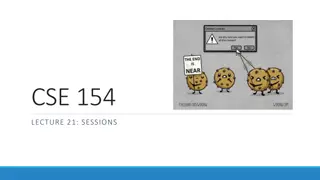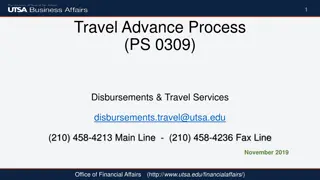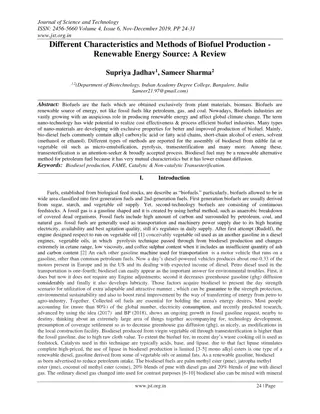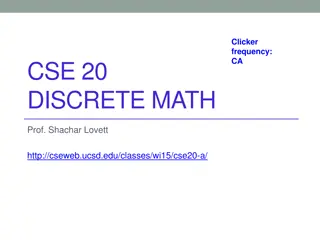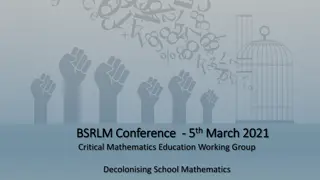Key Instructional Advances in Mathematics: Day One Sessions
The exploration of key advances in mathematics focusing on major work of each level, coherence, rigor, and implications for instruction. Major areas of focus in Level A and B included.
Download Presentation

Please find below an Image/Link to download the presentation.
The content on the website is provided AS IS for your information and personal use only. It may not be sold, licensed, or shared on other websites without obtaining consent from the author.If you encounter any issues during the download, it is possible that the publisher has removed the file from their server.
You are allowed to download the files provided on this website for personal or commercial use, subject to the condition that they are used lawfully. All files are the property of their respective owners.
The content on the website is provided AS IS for your information and personal use only. It may not be sold, licensed, or shared on other websites without obtaining consent from the author.
E N D
Presentation Transcript
Exploration of Key Instructional Advances in Mathematics Mimi Alkire of StandardsWork, Inc. U.S. Department of Education Office of Career, Technical, and Adult Education Day One
Mathematics Coaches Kaye Forgione Joanne Kantner Henry Kranendonk Chonda Long Fabio Milner 2
Day One Mathematics Work Sessions 10:15 11:15 a.m. Focusing on the Major Work of Each Level 11:15 a.m. noon Thinking Across Levels to Connect Learning Noon 1:15 p.m. Lunch 1:15 2:00 p.m. Thinking Across Levels to Connect Learning (continued) 2:00 3:45 p.m. Integrating the Mathematical Practices Into Lessons 3
Recap of the Three Key Advances Prompted by the CCR Standards 1. Focus: Focus strongly where the CCR standards focus. 2. Coherence: Design learning around coherent progressions level to level. 3. Rigor: Pursue conceptual understanding, procedural skill and fluency, and application all with equal intensity. 4
Mathematics Advance One: Focus Strongly Where the CCR Standards Focus 5
Implications for Instruction Focus where the CCR standards focus means that some content is more important than other content: Focusing narrows but deepens the scope of content and shows the power of the eraser. Rather than a mile wide and an inch deep, focusing results in a mile deep and an inch wide. Focusing opens the door to strengthening understanding fewer topics on the list means more time to spend on each one. Other content supports the more important content ow what we call the major work of the level. 6
Major Areas of Focus Level A: Whole numbers addition and subtraction concepts, skills, and problem solving to 20; place value and whole number relationships to 100; and reasoning about geometric shapes and linear measures Level B: Whole numbers and fractions place value, comparison, and addition and subtraction to 1000, fluency to 100; multiplication and division to 100; fractions concepts, skills, and problem solving; and 2-dimensional shape concepts; standard units and area measurements 7
Major Areas of Focus Level C: Whole numbers, fractions, and decimals fluency with multi-digit whole number and decimal operations; decimal place value concepts and skills to thousandths; comparing, ordering, and operating with fractions; fluency with sums and differences of fractions; understanding rates and ratios; early expressions and equations; the coordinate plane, including creating dot plots from data; area, surface area, and volume; classification of 2-dimensional shapes; and developing understanding of data distributions 8
Major Areas of Focus Level D: Rational numbers fluent arithmetic of positive and negative rational numbers; rates, ratios, and proportions; linear expressions, equations, and functions; classification and analysis of 2- and 3-dimensional figures; similarity and congruence concepts; random sampling of populations to summarize, describe, display, interpret, and draw inferences; and development of probability concepts 9
Major Areas of Focus Level E: Real numbers extending number system to include all real numbers; expressions involving radicals and integer exponents; reasoning with units and levels of precision; linear, quadratic, exponential expressions, equations, and functions; linear inequalities; algebraic and graphic models of functions; right triangle relationships; probability concepts; and 1- and 2-variable data sets, including frequency tables 10
Focusing on the Major Work of Each Level Purpose of Activity Materials Directions Begin Activity 11
Mathematics Advance Two: Design Learning Around Coherent Progressions Level to Level 12
Implications for Instruction Lessons should build new understanding on foundations based on previous lessons or levels so that content unfolds meaningfully. Explicit connections between concepts should be made in lessons across the levels but also within each level. Students and teachers should begin to expect knowledge and skills to build and grow: Each standard is not a new event, but rather an extension of previous learning. 13
Thinking Across Levels to Connect Learning Purpose of Activity Materials Directions Fluency, Expressions and Equations, and Applications Begin Activity 14
Thinking Across Levels to Connect Learning Purpose of Activity Materials Directions Fluency, Expressions and Equations, and Applications Continue Activity 15
Connect the Standards for Mathematical Practice to content in both instruction and assessment. 16
Implications for Instruction The Standards for Mathematical Practice are meant to be applied across all levels. Not all Standards for Mathematical Practice are appropriate for every lesson focus should only be on those practices that are central to the lesson. Make sure there are opportunities to experience all of the Standards for Mathematical Practice for students over the course of the unit or the level of study. 17
Standards for Mathematical Practice MP.1 Make sense of problems and persevere in solving them. MP.2 Reason abstractly and quantitatively. MP.3 Construct viable arguments and critique the reasoning of others. MP.4 Model with mathematics. MP.5 Use appropriate tools strategically. MP.6 Attend to precision. MP.7 Look for and make use of structure. MP.8 Look for and express regularity in repeated reasoning. 18
Integrating the Standards for Mathematical Practices Into Lessons (Part 1) Purpose for Activity Materials Directions Begin Activity 19
Integrating the Standards for Mathematical Practices Into Lessons (Part 2) Purpose for Activity Materials Directions Begin Activity 20
Exploration of Key Instructional Advances in Mathematics Mimi Alkire of StandardsWork, Inc. U.S. Department of Education Office of Career, Technical, and Adult Education (OCTAE) Day Two
Resources: Common Core Standards Initiative: http://www.corestandards.org/Math/ Illustrative Mathematics: http://www.illustrativemathematics.org OER Commons: http://www.oercommons.org NCTM http://www.nctm.org/resources/ NCSM: Network-Communicate-Support-Communicate https://www.mathedleadership.org/ccss/itp/index.html The University of Arizona Bill McCallum Progressions http://ime.math.arizona.edu/progressions/ 23
Whats New in Mathematics Assessments? 24
Key Advances in Assessments Emphasis is on the components of rigor: conceptual understanding, procedural fluency, and application Focus is on the major work of the levels 25
Special Role of Technology in Advancing Assessments From To Machine scorable multi-step tasks that ask for deep understanding of the concepts and are efficient to administer and score Bubble sheets or selected response Transformative formats that allow for simulations, audio input, drawing tools, etc. Paper and pencil Simple right-or-wrong responses Capturing complex student responses through open ended questions and device interface Providing increased accessibility (e.g., zoom in or hover over a word to hear it or see its definition) Limited accessibility 26
Mathematics Advance Three: Pursue Conceptual Understanding, Procedural Skill and Fluency, and Application All With Equal Intensity 27
Implications for Instruction Rigor in lessons relates to the depth at which the major work of each level should be addressed: Conceptual Understanding: Lessons should help students deeply understand key concepts and see math as more than a set of discrete procedures. Fluency: Some class time and homework should be devoted to students practice with calculations and mathematical procedures so they gain speed and accuracy. Application: Fluency practice is critical but not an end in itself; rather it is used to support problem solving and deeper mathematical thinking. 28
Why Are the Three Components Necessary? Knowing more than how to get the answer allows students to generalize knowledge to new situations and types of problems (conceptual understanding and application). Being able to perform core calculations quickly and accurately allows students to extend to more complex mathematical thinking (fluency). Engaging with equal intensity ensures that students will have all the tools they need to apply their knowledge to a wide variety of problems. 29
Example for Applying the Components of Rigor Conceptual Understanding: They need to comprehend why 7 x 8 is 56. Fluency: Students need to simply know that 7 x 8 is 56. Application: They need to know the benefit of knowing that 7 x 8 is 56. 30
Engaging the Three Components of Rigor Purpose for Activity Materials Directions Begin Activity 31
College and Career Readiness Standards for Mathematics Mimi Alkire malkire@standardswork.org
